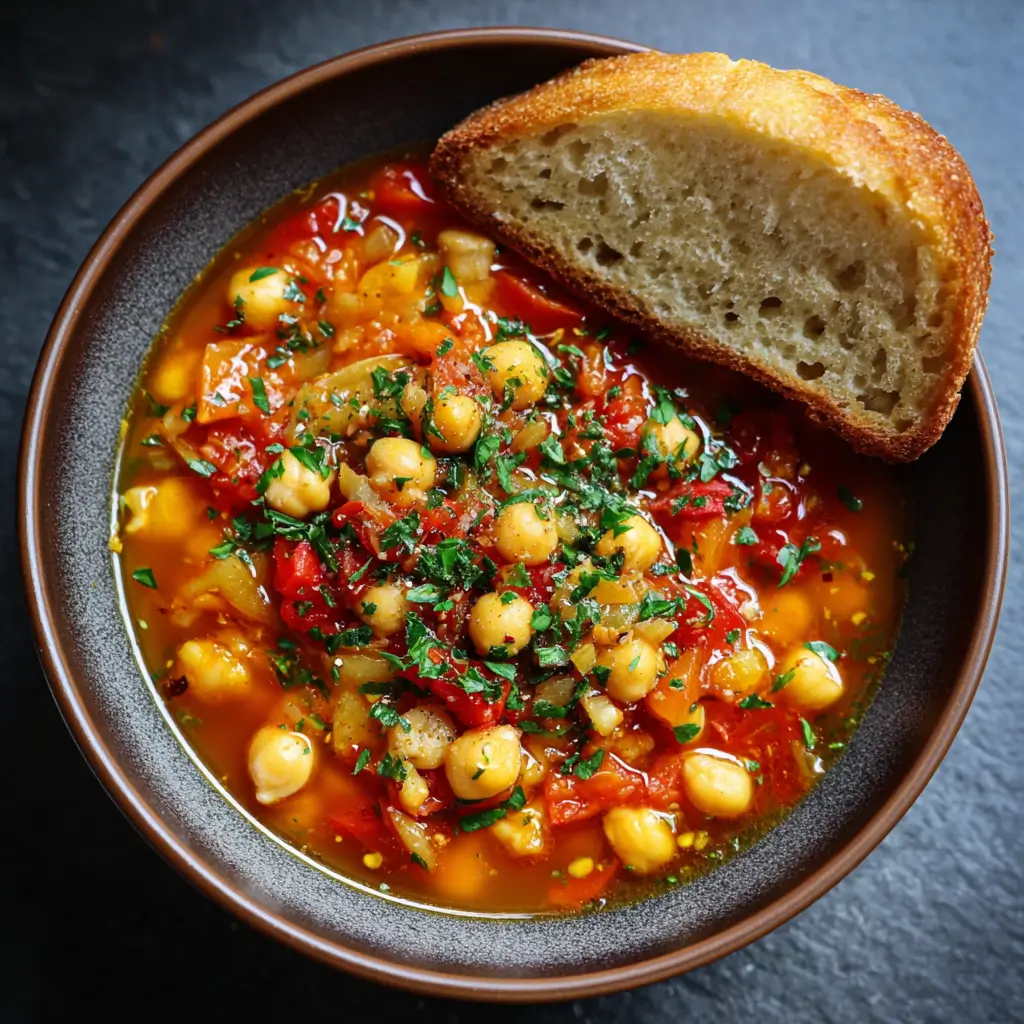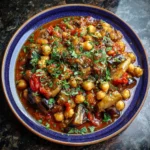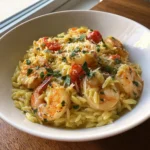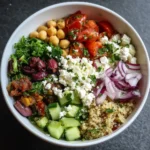Mediterranean Chickpea Stew: A Flavorful Journey Through the Sun-Kissed Shores of the Mediterranean
The Mediterranean diet has long been celebrated for its health benefits, vibrant flavors, and emphasis on whole, plant-based foods. Among its many culinary treasures is the humble yet deeply satisfying chickpea stew—a dish that unites the earthy richness of legumes with the bright, aromatic spices and herbs of the region. This hearty stew, known in various forms across countries like Greece, Turkey, Lebanon, Italy, and Morocco, is a testament to the simplicity and nourishment that defines Mediterranean cuisine. Whether enjoyed as a main course or a side dish, Mediterranean Chickpea Stew offers warmth, comfort, and a celebration of seasonal ingredients.
The History of Mediterranean Chickpea Stew
Chickpeas have been a staple in Mediterranean and Middle Eastern diets for thousands of years. Archaeological evidence traces their cultivation back to the Neolithic period, around 7500 BCE, in the Fertile Crescent—modern-day Turkey, Syria, and Lebanon. From there, chickpeas spread across the Mediterranean basin via ancient trade routes, becoming integral to cuisines from Spain to Egypt. In ancient Greece and Rome, chickpeas were commonly boiled and seasoned with olive oil, garlic, and herbs—precursors to today’s stews.
Over centuries, regional variations emerged. In North Africa, chickpeas were simmered with warming spices like cumin and coriander in tagines. In the Levant, they formed the base of dishes like shorbat hummus, a spiced soup served during Ramadan. In Southern Italy, particularly Sicily, chickpeas were slow-cooked into thick, rustic stews often flavored with tomatoes, rosemary, and anchovies. The modern Mediterranean Chickpea Stew draws inspiration from all these traditions, blending them into a cohesive, nutritious, and flavorful one-pot meal that honors its ancestral roots while embracing contemporary tastes.
Ingredients Breakdown: What Makes This Stew So Special?
The magic of Mediterranean Chickpea Stew lies in its balance of textures, flavors, and nutrients. Each ingredient contributes not only to taste but also to the stew’s overall harmony and health profile. Let’s explore the key components:
- Chickpeas (Garbanzo Beans): The star of the dish, chickpeas are packed with plant-based protein, fiber, iron, and complex carbohydrates. They provide a creamy texture and nutty flavor that absorbs the surrounding seasonings beautifully.
- Olive Oil: A cornerstone of the Mediterranean diet, extra virgin olive oil adds richness, heart-healthy monounsaturated fats, and a fruity aroma. It’s used both for sautéing and finishing the stew.
- Onions, Garlic, and Leeks: These aromatic vegetables form the flavor base. When slowly caramelized, they lend sweetness and depth to the broth.
- Tomatoes: Fresh, canned, or sun-dried tomatoes bring acidity, brightness, and natural umami. They help cut through the richness of the chickpeas and oil.
- Carrots and Celery: Part of the classic mirepoix, these vegetables add earthiness, texture, and subtle sweetness when cooked down.
- Vegetable or Chicken Broth: A quality broth enhances the savory backbone of the stew. Homemade versions deepen the flavor, but store-bought works well too.
- Fresh Herbs: Parsley, oregano, thyme, and rosemary are commonly used. They infuse the stew with freshness and herbal complexity.
- Lemon Juice: A splash at the end brightens the entire dish, balancing richness and enhancing other flavors.
- Spices: Cumin, smoked paprika, turmeric, and red pepper flakes are typical. These spices add warmth, color, and a gentle kick without overwhelming the palate.
- Kalamata Olives or Capers (optional): For a briny, salty contrast that elevates the stew’s Mediterranean character.
- Spinach or Swiss Chard: Leafy greens add color, nutrients, and a slight bitterness that complements the sweetness of the vegetables.
- Feta Cheese (optional): Crumbled feta on top adds creaminess and tang, though the stew remains vegan without it.
Step-by-Step Recipe: How to Make Authentic Mediterranean Chickpea Stew
Follow this detailed guide to create a rich, aromatic, and satisfying chickpea stew that captures the essence of the Mediterranean.
- Prep the Ingredients: Drain and rinse 2 cans (15 oz each) of chickpeas. Chop 1 large onion, 2 carrots, 2 celery stalks, and 3 cloves of garlic. Measure out 1 can (14.5 oz) of diced tomatoes, 4 cups of vegetable broth, 2 tbsp olive oil, 1 tsp ground cumin, 1/2 tsp smoked paprika, 1/4 tsp turmeric, 1 tsp dried oregano, salt, and pepper. Wash and roughly chop 2 cups of fresh spinach or Swiss chard.
- Sauté the Aromatics: Heat olive oil in a large pot or Dutch oven over medium heat. Add onions, carrots, and celery. Cook for 8–10 minutes, stirring occasionally, until softened and slightly golden. Add garlic and cook for another minute until fragrant.
- Add Spices: Stir in cumin, smoked paprika, turmeric, and oregano. Toast the spices for about 30 seconds to release their essential oils and deepen their flavor.
- Incorporate Tomatoes and Broth: Pour in the diced tomatoes (with juices) and stir to combine. Then add the vegetable broth and bring the mixture to a gentle boil.
- Add Chickpeas: Stir in the rinsed chickpeas. Reduce heat to low, cover, and simmer for 25–30 minutes, allowing the flavors to meld and the stew to thicken slightly.
- Add Greens: Stir in the chopped spinach or chard and cook for an additional 5 minutes until wilted.
- Season and Finish: Taste and adjust seasoning with salt and pepper. Squeeze in the juice of half a lemon just before serving. This brightens the stew and enhances the overall flavor profile.
- Serve: Ladle into bowls and drizzle with a little extra virgin olive oil. Top with crumbled feta, fresh parsley, and a sprinkle of red pepper flakes if desired. Serve with crusty whole-grain bread, pita, or over couscous or quinoa for a complete meal.
Tips for Perfect Mediterranean Chickpea Stew
- Use Dried Chickpeas for Ultimate Flavor: While canned chickpeas are convenient, cooking dried chickpeas from scratch (soaked overnight and boiled with a pinch of baking soda) yields a creamier texture and richer taste. You can prepare a large batch and freeze portions for future use.
- Don’t Rush the Sauté: Taking time to properly soften the onions, carrots, and celery builds a deeper flavor foundation. Low and slow is key.
- Bloom the Spices: Always toast dry spices in oil for 20–30 seconds before adding liquids. This step unlocks their full aromatic potential.
- Simmer, Don’t Boil: Keep the heat low during the simmering phase to prevent the vegetables from breaking down too much and to allow flavors to develop gradually.
- Acid is Essential: Never skip the lemon juice. Acid balances richness and makes the other flavors pop. Balsamic vinegar or red wine vinegar can be used as alternatives.
- Let it Rest: Like many stews, this dish tastes even better the next day. The flavors continue to meld as it sits, so consider making it ahead of time.
- Freeze for Later: This stew freezes beautifully. Store in airtight containers for up to 3 months. Thaw in the refrigerator and reheat gently on the stove.
Variations and Customizations
Mediterranean Chickpea Stew is incredibly versatile. Here are some creative ways to adapt it to your taste or dietary needs:
- Vegan & Gluten-Free: The base recipe is naturally both vegan and gluten-free. Just ensure your broth is certified GF if needed.
- Protein Boost: Add cubed tofu, tempeh, or cooked lentils for extra plant-based protein. For non-vegetarians, shredded chicken or chorizo can be stirred in.
- Creamier Texture: Blend 1 cup of the stew and stir it back in for a thicker consistency. Alternatively, stir in a tablespoon of tahini or coconut milk.
- Middle Eastern Twist: Add a dash of cinnamon, allspice, and mint. Top with toasted pine nuts and serve with warm pita.
- Greek Style: Include diced zucchini, bell peppers, and Kalamata olives. Finish with dill and feta cheese.
- Italian-Inspired: Use rosemary instead of oregano, add cannellini beans, and finish with a spoonful of pesto.
- Spicy Version: Increase red pepper flakes or add harissa paste or a diced jalapeño for heat.
- Roasted Vegetable Addition: Toss in roasted eggplant, red peppers, or tomatoes for added smokiness and depth.
Health Considerations and Nutritional Value
Mediterranean Chickpea Stew isn’t just delicious—it’s a powerhouse of nutrition. Here’s why it’s a smart choice for anyone seeking a balanced, wholesome diet:
- High in Fiber: Chickpeas and vegetables provide abundant dietary fiber, promoting digestive health, regulating blood sugar, and supporting satiety.
- Plant-Based Protein: With about 10–15 grams of protein per serving, this stew is ideal for vegetarians and vegans looking to meet daily protein needs.
- Heart-Healthy Fats: Olive oil delivers monounsaturated fats that support cardiovascular health and reduce inflammation.
- Rich in Vitamins and Minerals: Carrots offer beta-carotene (vitamin A), tomatoes provide vitamin C and lycopene, and leafy greens contribute iron, calcium, and folate.
- Low Glycemic Index: The combination of fiber, protein, and healthy fats helps maintain steady energy levels without spiking blood sugar.
- Anti-Inflammatory Properties: Turmeric contains curcumin, a compound known for its anti-inflammatory and antioxidant effects.
- Supports Weight Management: High volume, low-calorie density, and nutrient richness make this stew filling without being heavy.
Nutritional Estimate (per serving, serves 6):
- Calories: ~220–250
- Protein: 10–12g
- Fat: 8–10g (mostly unsaturated)
- Carbohydrates: 35–40g
- Fiber: 9–11g
- Sodium: Varies by broth; ~400–600mg (lower if using low-sodium options)
Full Ingredient List
- 2 tablespoons extra virgin olive oil
- 1 large yellow onion, diced
- 2 medium carrots, peeled and sliced
- 2 celery stalks, sliced
- 3 garlic cloves, minced
- 1 teaspoon ground cumin
- 1/2 teaspoon smoked paprika
- 1/4 teaspoon ground turmeric
- 1 teaspoon dried oregano
- 1 (14.5 oz) can diced tomatoes (preferably fire-roasted)
- 2 (15 oz) cans chickpeas, drained and rinsed
- 4 cups low-sodium vegetable broth
- Salt and freshly ground black pepper, to taste
- 2 cups fresh spinach or chopped Swiss chard
- Juice of 1/2 lemon
- Optional toppings: crumbled feta cheese, chopped fresh parsley, extra olive oil, red pepper flakes, Kalamata olives
Detailed Directions
- In a large, heavy-bottomed pot or Dutch oven, heat the olive oil over medium heat.
- Add the onion, carrots, and celery. Season lightly with salt and cook, stirring occasionally, for 8–10 minutes until vegetables are soft and beginning to caramelize.
- Stir in the minced garlic and cook for 1 minute until fragrant.
- Add the cumin, smoked paprika, turmeric, and oregano. Stir constantly for 30 seconds to toast the spices.
- Pour in the diced tomatoes with their juices and stir to combine. Cook for 2 minutes to reduce slightly.
- Add the chickpeas and vegetable broth. Bring the mixture to a boil, then reduce heat to low.
- Cover and simmer gently for 25–30 minutes, stirring occasionally, until the stew has thickened and flavors are well blended.
- Stir in the spinach or chard and cook for 5 minutes until wilted.
- Remove from heat. Stir in lemon juice. Taste and adjust seasoning with salt and pepper as needed.
- Ladle into bowls and garnish with optional toppings. Serve immediately with crusty bread or grain of choice.
Frequently Asked Questions (FAQ)
Can I make this stew in a slow cooker?
Yes! Sauté the aromatics and toast the spices in a pan first, then transfer everything to a slow cooker. Add remaining ingredients except spinach and lemon juice. Cook on low for 6–8 hours or high for 3–4 hours. Stir in greens and lemon juice before serving.
How long does it keep in the fridge?
The stew will stay fresh in an airtight container in the refrigerator for up to 5 days. Reheat gently on the stove with a splash of water or broth to loosen.
Can I use dried chickpeas instead of canned?
Absolutely. Soak 1 cup of dried chickpeas overnight, then cook until tender (about 1–1.5 hours). Use 2.5–3 cups cooked chickpeas in place of canned. They’ll have a superior texture and flavor.
Is this stew freezer-friendly?
Yes, it freezes very well. Cool completely, then store in portion-sized containers for up to 3 months. Thaw overnight in the fridge and reheat on the stove.
Can I make it spicy?
Definitely. Add 1/2 teaspoon crushed red pepper flakes, a diced fresh chili, or a spoonful of harissa paste when sautéing the vegetables.
What can I serve with this stew?
Excellent pairings include whole grains (quinoa, farro, brown rice), crusty sourdough bread, flatbreads, Greek yogurt, or a simple arugula salad with lemon vinaigrette.
Is it suitable for meal prep?
Perfect for meal prep! It reheats well and gets tastier over time. Prepare a big batch on Sunday for easy, healthy lunches or dinners all week.
Summary
Mediterranean Chickpea Stew is a nourishing, aromatic, and adaptable dish that brings the vibrant flavors of the Mediterranean to your table with minimal effort and maximum reward. Packed with plant-based protein, fiber, and heart-healthy ingredients, it’s a celebration of wholesome eating and culinary tradition.










